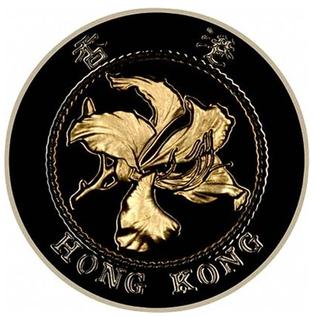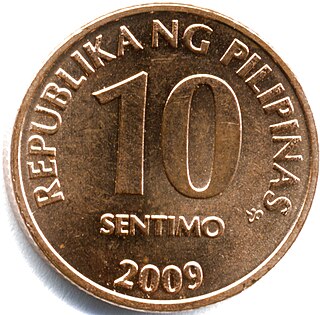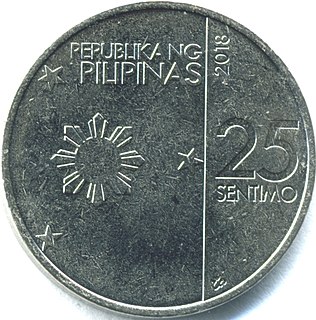The Thailand one-satang coin is a currency unit equivalent to one-hundredth of a Thai baht. It is rare in circulation but used in banking transactions.
The Thailand five-satang coin is a unit of currency equivalent to one-twentieth of a Thai baht. It was introduced in 1908 as a coin with a hole through its middle, which was minted until 1939. In 1946 the hole was removed and the new Thai monarch featured on the obverse: Rama IX. In 1996 a five-satang coin marked the 50th anniversary of his reign.

The one-dollar coin is the fourth-highest and fourth-lowest denomination coin of the Hong Kong dollar.
This article concerns the coins of the New Zealand dollar.

The twenty-five øre coin was a coin of the Danish krone. It was the lowest-denomination coin in the country when it was demonetised on 1 October 2008.
The ten-cent coin is the lowest-denomination circulating coin of the Hong Kong dollar. With a diameter of 17.5 mm and a mass of 1.85 g it is also the smallest in size and weight. It is the oldest coin denomination to still be in circulation in Hong Kong. Since its first issue in 1863, there has only been one period (1942–1947) where the coin was not in use.

The ten-dollar coin is the highest-valued circulating coin issued in Hong Kong.
The five dollar coin is the second-highest denomination coin of the Hong Kong dollar. It replaced the five dollar banknotes in 1976.

The two dollar coin is the third-highest denomination coin of the Hong Kong dollar. Since its introduction in 1976, it is one of two circulating coins to not be round. The two dollar coin is a dodecagonal scallop in shape, and made of cupro-nickel.
The fifty-cent coin was first introduced as a .900 purity silver half dollar in 1866. These coins were 13.41 grams, with a diameter of 32 mm, thickness of 2 mm, and a reeded edge. The design was similar to the British trade dollar, except the image of Britannia was replaced by Queen Victoria. The dates of issue were 1866-67 with only 59,000 issued for both dates combined.

The one-cent coin was the smallest-denomination coin of the Hong Kong dollar since 1866 until its replacement in 1941 by the one-cent note. During World War II the loss of coins dated 1941 along with their subsequent melting during the Japanese occupation of Hong Kong has resulted in the survival of no more than 100 coins.
The five-cent coin was first issued as a silver coin of .800 fineness in 1866. It had a diameter of 15 mm, thickness of 0.80 mm, weighed 1.34 grams, and had a reeded edge. This coin was minted in silver until 1935, when its composition was changed to copper-nickel. It had an extensive mintage between 1866 and 1933, with some issued in 1932-33 with a plain edge. The coin was not minted in 1869-71, 1878, 1896, and 1906-1932. The following copper-nickel denomination was identical in all aspects except the composition and weight: it weighed 1.36 grams, 0.02 grams heavier than the previous coin. This was a one-year type as it was replaced with a pure nickel coin in 1937. This time, it had a diameter of 16.51 mm, was 1.73 mm thick, and weighed 2.59 grams. This was minted until 1941, with the last issue being scarce. Unlike the very rare 1941 Hong Kong one-cent coin these are available, although were never released to circulation because of the Japanese occupation.
The Romanian one-ban coin is a unit of currency equalling one one-hundredth of a Romanian leu. It is the lowest-denomination coin of the present currency and has been minted every year since the leu was redenominated in 2005. As well as Romania, the coin has been minted in the United Kingdom (1867), Germany (1900) and Russia (1952).

The Philippine ten-centavo coin (10¢) coin is a denomination of the Philippine peso. It was the oldest denomination under 1 peso in the country's circulation, having been introduced in 1880 during the Spanish rule of the islands until it was stopped being minted in 2017. The denomination is still legal tender until the demonetization of the BSP Coin Series.

The Philippine twenty-five-centavo coin (25¢) coin is the third-lowest denomination coin of the Philippine peso.
The New Zealand two-dollar coin is the largest-denomination coin of the New Zealand dollar. It was introduced along with the one-dollar coin in 1990. Both are made from an alloy of aluminium and brass. It is the largest and heaviest coin in circulation, weighing ten grams and measuring 26.5 millimetres in diameter. Its thickness is 2.7 mm, only 0.4 mm thinner than the one-dollar coin, thus it is the second-thickest coin in the country's circulation.
The New Zealand one-cent coin was the smallest denomination coin of the New Zealand dollar from the currency's introduction in 1967 to its demonetisation, along with the two-cent coin, on 30 April 1990. With a diameter of 17.53 millimetres, it is the smallest coin ever issued of the dollar, and at 2.07 grams in mass the lightest as well. Its reverse featured a fern leaf, a sign of New Zealand, associated also with its national rugby union team. The image was designed by Reginald George James Berry, who designed the reverses for all coins introduced that year.
The New Zealand fifty-cent coin is a coin of the New Zealand dollar. It was the largest by denomination, diameter and mass to have been introduced on the decimalisation of the currency on 10 July 1967, replacing the pre-decimal crown coin. A total of 81,585,200 pre-2006 50 cent coins were issued, with a total value of $40,792,600.00
The five bani coin is a coin of the Romanian leu. It is the second-lowest denomination of the present circulating coins, introduced to circulation on 1 July 2005,
The ten-bani coin is a coin of the Romanian leu. It was reintroduced on 1 July 2005 and is the second-largest denomination coin in Romania. In addition to Romania, it has been minted in the United Kingdom (1867), Belgium, Germany (1906) and Russia (1952).






